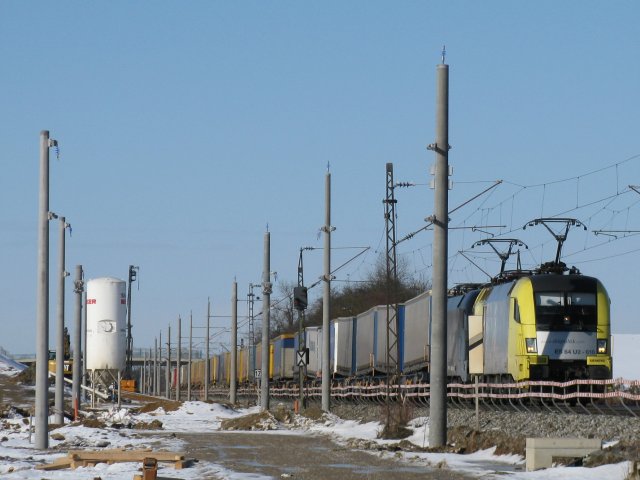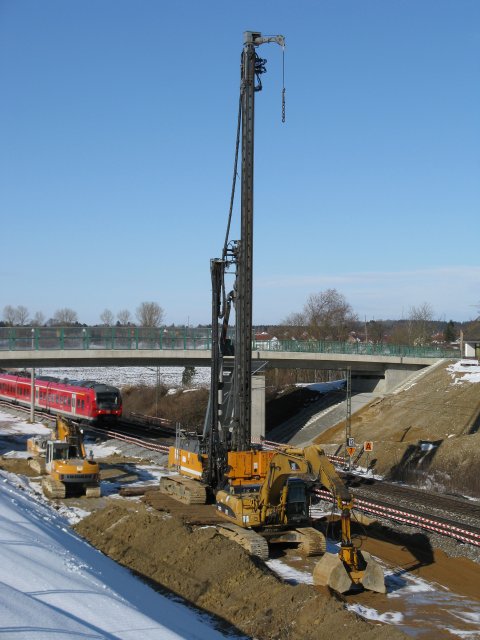Munich–Augsburg railway on:
[Wikipedia]
[Google]
[Amazon]
The Munich–Augsburg line connects


 The 43 km section between Augsburg and
The 43 km section between Augsburg and  On 6 June 2011, the conversion of the line to four-track operation was completed, but the two high-speed tracks were not yet passable at 230 km/h. On 10 December 2011 the railway was dedicated with a new speed limit of 230 km/h after 13 years of building.
On 6 June 2011, the conversion of the line to four-track operation was completed, but the two high-speed tracks were not yet passable at 230 km/h. On 10 December 2011 the railway was dedicated with a new speed limit of 230 km/h after 13 years of building.
Munich
Munich ( ; german: München ; bar, Minga ) is the capital and most populous city of the German state of Bavaria. With a population of 1,558,395 inhabitants as of 31 July 2020, it is the third-largest city in Germany, after Berlin and ...
and Augsburg
Augsburg (; bar , Augschburg , links=https://en.wikipedia.org/wiki/Swabian_German , label=Swabian German, , ) is a city in Swabia, Bavaria, Germany, around west of Bavarian capital Munich. It is a university town and regional seat of the ' ...
in the German state of Bavaria
Bavaria ( ; ), officially the Free State of Bavaria (german: Freistaat Bayern, link=no ), is a state in the south-east of Germany. With an area of , Bavaria is the largest German state by land area, comprising roughly a fifth of the total l ...
. It was built by the Munich-Augsburg Railway Company and opened in 1840. It was nationalised in 1846 and extended to Ulm in 1854. The line between Augsburg and Munich is a major traffic axis and part of the Magistrale for Europe from Budapest
Budapest (, ; ) is the capital and most populous city of Hungary. It is the ninth-largest city in the European Union by population within city limits and the second-largest city on the Danube river; the city has an estimated population o ...
through Vienna
en, Viennese
, iso_code = AT-9
, registration_plate = W
, postal_code_type = Postal code
, postal_code =
, timezone = CET
, utc_offset = +1
, timezone_DST ...
to Paris
Paris () is the capital and most populous city of France, with an estimated population of 2,165,423 residents in 2019 in an area of more than 105 km² (41 sq mi), making it the 30th most densely populated city in the world in 2020. Si ...
.
History
The line was built by the Munich-Augsburg Railway Company (German
German(s) may refer to:
* Germany (of or related to)
**Germania (historical use)
* Germans, citizens of Germany, people of German ancestry, or native speakers of the German language
** For citizens of Germany, see also German nationality law
**Ge ...
: ''München-Augsburg Eisenbahn-Gesellschaft'') and opened in 1839 and 1840. The Munich-Augsburg Railway Company was nationalised on 1 June 1846 and taken over by the Royal Bavarian State Railways (''Königlich Bayerische Staats-Eisenbahnen''). The line became part of Bavarian Maximilian’s Railway (''Bayerische Maximiliansbahn'') and was extended to Ulm on 1 May 1854. After the nationalisation of the line in 1846 a new Augsburg station was built at Rosenauberg along with new rail facilities in nearby Oberhausen. The old stations at the ''Roten Tor'' (Red Gate) and in Oberhausen were abandoned.
Between 26 June 1965 and 3 October 1965, two pairs of trains per day using Class E 03 locomotives ran at 200 km/h on the line for the 1965 International Transport Exhibition in Munich, taking 26 minutes to complete the run. From May 1968 two trains, "Blauer Enzian" and "Rheinblitz", ran on the same route at a scheduled speed of 200 km/h.
In 1977 the 42.7 km long section between Lochhausen
Aubing-Lochhausen-Langwied (Central Bavarian: ''Aubing-Lochhausn-Langwied'') is the 22nd borough of the German city of Munich. The districts Aubing, Lochhausen and Langwied were incorporated together in 1942, thus forming the largest borough of t ...
and Augsburg-Hochzoll, was put into operation with a regular permitted speed of 200 km/h. For the first time in Germany numerous trains could reach this speed in regular commercial operations.
Upgrade


 The 43 km section between Augsburg and
The 43 km section between Augsburg and Olching
Olching (Central Bavarian: ''Oiching'') is a town in the district of Fürstenfeldbruck, in Bavaria, Germany. It is situated approximately 20 km (12 mi) northwest of Munich.
Geography
Olching lies approximately halfway between Dachau ...
line was rebuilt to four-tracks between 1998 and 2011 to carry significantly more traffic. One pair of tracks was dedicated to regional services ( RB, RE) and goods traffic and the other to ( IC/ EC) and high-speed traffic ( ICE) services. Heavy and more slowly running freight trains no longer obstruct the passage of faster ICEs. The permitted speed on the high-speed tracks is now 230 km/h. Infrastructure for regional trains allows operations at 160 km/h. On the line between Olching and Munich, freight, regional trains, and the Munich S-Bahn
The Munich S-Bahn (german: S-Bahn München) is an electric rail transit system in Munich, Germany. " S-Bahn" is the German abbreviation for ''Stadtschnellbahn'' (literally, "urban rapid rail"), and the Munich S-Bahn exhibits characteristics of ...
have their own tracks.
The railway upgrading work was divided into six sections for planning purposes. Work began on the western section between Augsburg and Kissing in February 1998 and the new tracks were brought into service in 2003. A new bridge was built over the Lech in Augsburg in 2002 and in the same year work began on the eastern section between Mering
Mering is a municipality in the district Aichach-Friedberg, in Bavaria, Germany. It is located on the river Paar.
First mentioned in records in 1021, Mering has a long history.
The growing town with its nearly 15,000 inhabitants (2021) profits f ...
and Olching.
 On 6 June 2011, the conversion of the line to four-track operation was completed, but the two high-speed tracks were not yet passable at 230 km/h. On 10 December 2011 the railway was dedicated with a new speed limit of 230 km/h after 13 years of building.
On 6 June 2011, the conversion of the line to four-track operation was completed, but the two high-speed tracks were not yet passable at 230 km/h. On 10 December 2011 the railway was dedicated with a new speed limit of 230 km/h after 13 years of building.
Dates and facts
*Length of the Augsburg–Munich line: *Length of the line being upgraded: *Line speed: for ICE traffic; for regional and goods traffic *Completion date: 2011 The upgrading involved: acquisition of 95.3 hectares of land, 43 km of additional railway embankment, 7.5 km of new retaining walls, 116 km of new track and 104points
Point or points may refer to:
Places
* Point, Lewis, a peninsula in the Outer Hebrides, Scotland
* Point, Texas, a city in Rains County, Texas, United States
* Point, the NE tip and a ferry terminal of Lismore, Inner Hebrides, Scotland
* Points ...
moved, 52 railway and 19 road bridges reconstructed or adapted, 46 km of noise barriers, nine island platforms and three passing lines adapted or rebuilt
In the federal transport investment plan for 2010, federal funding for the project was estimated to be €556 million for the first stage of development (2006 prices). €303.5 million had been spent up to 2005. €215 million of federal funds were to be invested between 2006 and 2010. Beyond this period a shortfall of €37.6 million had to be made up.
Operations
The line between Augsburg and Munich is a major traffic axis and part of the ''Magistrale'' (trunk line) ''for Europe'' from Budapest through Vienna to Paris. It is used daily by about 300 trains and is one of Germany’s busiest line with a mixture of goods trains, regional passenger trains and long-distance high-speed trains. Each hour anIntercity-Express
The Intercity Express (commonly known as ICE ()) is a system of high-speed trains predominantly running in Germany. It also serves some destinations in Austria, Denmark (ceased in 2017 but planned to resume in 2022), France, Belgium, Switzerl ...
train and an InterCity
InterCity (commonly abbreviated ''IC'' on timetables and tickets) is the classification applied to certain long-distance passenger train services in Europe. Such trains (in contrast to regional, local, or commuter trains) generally call at m ...
train run from Munich via Ulm to Stuttgart
Stuttgart (; Swabian: ; ) is the capital and largest city of the German state of Baden-Württemberg. It is located on the Neckar river in a fertile valley known as the ''Stuttgarter Kessel'' (Stuttgart Cauldron) and lies an hour from the Sw ...
. Additional ICE trains run from Munich to Augsburg, branching to Nuremberg
Nuremberg ( ; german: link=no, Nürnberg ; in the local East Franconian dialect: ''Nämberch'' ) is the second-largest city of the German state of Bavaria after its capital Munich, and its 518,370 (2019) inhabitants make it the 14th-largest ...
or Würzburg and on to further destinations. A similar service pattern also operates in the reverse direction.
Regional-Express trains also run hourly between Munich and Augsburg, alternating to/from Ulm and Donauwörth.
From Mammendorf
Mammendorf is a municipality in Bavaria, Germany. It is located halfway between Munich and Augsburg.
Location
Mammendorf is part of the district of Fürstenfeldbruck, Upper Bavaria and lies about 6 kilometres northwest of the city of Fürstenfe ...
to Munich central station the line runs parallel to line S3 of the Munich S-Bahn
The Munich S-Bahn (german: S-Bahn München) is an electric rail transit system in Munich, Germany. " S-Bahn" is the German abbreviation for ''Stadtschnellbahn'' (literally, "urban rapid rail"), and the Munich S-Bahn exhibits characteristics of ...
of the MVV
Maatschappelijke Voetbal Vereniging Maastricht (), commonly known as MVV Maastricht (, ) or simply as MVV, is a Dutch professional football club from the city of Maastricht. Founded on 2 April 1902, MVV Maastricht currently compete in the Eerst ...
.
References
External links
{{DEFAULTSORT:Munich-Augsburg railway Railway lines in Bavaria High-speed railway lines in Germany Rail transport in Augsburg Rail transport in Munich Railway lines opened in 1840 1840 establishments in Bavaria Buildings and structures in Fürstenfeldbruck (district) Buildings and structures in Aichach-Friedberg